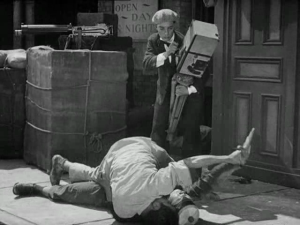The General (1926)
The General holds the distinction of being one of the two most famous Buster Keaton films ever made, and consequently the one most often seen even by those who might resist silent cinema. And what a film it is. The General spends the vast majority of its hour and fifteen minute runtime in a breathless chase sequence, with stunts that become ever more elaborate as Keaton and his crew risk life and limb for the sake of a good joke. In this new restoration from Kino Lorber and Lobster Films, we can finally watch The General in all its gorgeous glory (and in the original aspect ratio!).
Keaton is Johnnie Grey, an engineer on the Western & Atlantic Railroad who loves two things: his engine The General, and his girl Annabelle Lee (Marion Mack). When the Civil War breaks out, Annabelle pressures Johnnie to enlist, but the Confederate Army thinks that he’d be more useful as an engineer than as a soldier. Believing her man is a coward, Annabelle refuses to have anything more to do with Johnnie until he puts on a uniform. Fast forward a year, and Annabelle is traveling on the Western & Atlantic to go see her father, who has been injured further North. Little does she – or Johnnie – know, but The General is the target for Union saboteurs, who steal the train with Annabelle still on board. Johnnie gives chase, vowing to bring back his engine and his girl.
The stunts in The General are some of the most remarkable that Keaton would ever pull off, with the comedian riding on the cow catcher, running over the top of the train cars, firing cannons around bends, and setting a bridge on fire. But the stunts also pay off as shocking feats of athletic – and locomotive – prowess that today would take ten stuntmen and lots of insurance forms. The directing and editing of the film plays a large part in The General’s success, maintaining a breakneck speed and elegance that provides a study in continuity editing.
The odd quirks of The General – such as Keaton insisting that the heroes be the Confederate Army, because no one would have sympathy with the Union – don’t serve to undermine it. While the Civil War acts as a backdrop, and there is an undercurrent of the South’s heroism, it’s a very apolitical film, more about the triumph of the little man than about any big victory for the rebels.
Three Ages (1923)
Lesser known than The General or even than the other two films in Kino’s other Keaton collection is Three Ages, an underrated little gem from 1923.
Three Ages gently mocks D.W. Griffith’s Intolerance by taking a similar structure and subject matter, telling of universal human experience through three stories from three different periods of history. Keaton here takes on “love” through the lenses of the Stone Age, the Roman Age, and the Modern Age, each depicted with tongue firmly in cheek. The structure is really just an excuse for Keaton to do his stunts, and the plot is less integral to the stunts than in The General or Steamboat Bill, Jr. But the stunts are, as always, glorious to behold, particularly in the climactic chase scenes at the end of each historical sequence. There are also wonderful little bouts of silliness, as when Keaton’s Roman counterpart runs a chariot race by dog sled, or the acrobatic football game in which the slight comedian faces off against the massive Wallace Beery.
Three Ages is probably one of the sillier Keaton films, and the episodic structure means that the viewer more or less knows what to expect in each sequence. But without being groundbreaking, it’s also quite entertaining.
As with the Steamboat Bill, Jr. and College set, this set from Kino Lorber and Lobster Films features gorgeous 2K restorations of Keaton’s classics, along with a hefty dose of extras on both discs. For the film buffs among us, the audio commentary from film historians on The General is interesting, especially as this is among the best known of Keaton’s works. Three Ages doesn’t receive quite the same attention, though the inclusion of Man’s Genesis, another Griffith film parodied in the Stone Age sequence in Three Ages, is a welcome historical tidbit.Three Ages is unfortunately a visibly damaged film, with several scenes almost obscured by damaged frames. But this restoration thankfully makes even those scenes watchable, and the film is here presented in its entirety.
What’s really most impressive and important in these new Kino releases is the beauty and the care that has gone into the restorations. Thousands of silent films have been lost, and many more have disintegrated beyond repair, so even the smallest attempts to preserve silent film history is welcome in the digital age. And these are not small films, nor are the preservation attempts – they are seminal comedies from one of the greatest comedic minds of his or any other generation, presented with loving attention to detail in crisp digital prints. Embrace these films, watch them, buy them. Support the preservation of our cinematic history. We won’t see anything like this again.
The General/Three Ages is now available from Kino Lorber.





